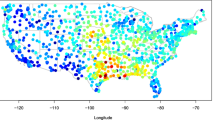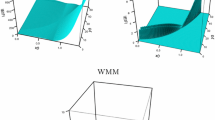Abstract
The use of kriging for construction of prediction or risk maps requires estimating the dependence structure of the random process, which can be addressed through the approximation of the covariance function. The nonparametric estimators used for the latter aim are not necessarily valid to solve the kriging system, since the positive-definiteness condition of the covariance estimator typically fails. The usage of a parametric covariance instead may be attractive at first because of its simplicity, although it may be affected by misspecification. An alternative is suggested in this paper to obtain a valid covariance from a nonparametric estimator through the Fourier series tool, which involves two issues: estimation of the Fourier coefficients and selection of the truncation point to determine the number of terms in the Fourier expansion. Numerical studies for simulated data have been conducted to illustrate the performance of this approach. In addition, an application to a real environmental data set is included, related to the presence of nitrate in groundwater in Beja District (Portugal), so that pollution maps of the region are generated by solving the kriging equations with the use of the Fourier series estimates of the covariance.



Similar content being viewed by others
References
Chen X (2005) Statistical and geostatistical features of streambed hydraulic conductivities in the Platte River, Nebraska. Environ Geol 48:693–701. doi:10.1007/s00254-005-0007-1
Christakos G (1984) On the problem of permissible covariance and variogram models. Water Resour Res 20:251–265. doi:10.1029/WR020i002p00251
Cressie N (1993) Statistics for spatial data. Wiley, New York
Cressie N, Hawkins D (1980) Robust estimation of the variogram. Math Geol 12:115–125. doi:10.1007/BF01035243
Diggle P, Hall P (1986) The selection of terms in an orthogonal series density estimator. J Am Stat Assoc 81:230–233
Efromovich S (1999) Nonparametric curve estimation: methods, theory and applications. Springer, New York
Eubank RL (1988) Spline smoothing and nonparametric regression. Marcel and Dekker, New York
García-Soidán P (2007) Asymptotic normality of the Nadaraya-Watson semivariogram estimators. TEST 16:479–503. doi:10.1080/10485250902878655
Genton MG (1998) Highly robust variogram estimation. Math Geol 30:213–221. doi:10.1023/A:1021728614555
Hall P, Patil P (1994) Properties of nonparametric estimators of autocovariance for stationary random fields. Probab Theory Relat Fields 99:399–424. doi:10.1007/BF01199899
Hall P, Fisher NI, Hoffman B (1994) On the nonparametric estimation of covariance functions. Ann Stat 22:2115–2134. doi:10.1214/aos/1176325774
Hart JD (1985) On the choice of a truncation point in Fourier series density estimation. J Stat Comput Simul 21:95–116. doi:10.1080/00949658508810808
Huang B, Hu T (2009) BLP approach for estimation of variogram parameters. Environ Earth Sci 59:421–428. doi:10.1007/s12665-009-0040-6
LaMotte AE, Green EA (2007) Spatial analysis of land use and shallow groundwater vulnerability in the watershed adjacent to Assateague Island National Seashore, Maryland and Virginia, USA. Environ Geol 52:1413–1421. doi:10.1007/s00254-006-0583-8
Lark RM (2000) A comparison of some robust estimators of the variogram for use in soil survey. Eur J Soil Sci 51:137–157. doi:10.1046/j.1365-2389.2000.00280.x
Lin YP, Chu HJ, Huang YL, Cheng BY, Chang TK (2011) Modeling spatial uncertainty of heavy metal content in soil by conditional Latin hypercube sampling and geostatistical simulation. Environ Earth Sci 62:299–311. doi:10.1007/s12665-010-0523-5
Matheron G (1963) Principles of geostatistics. Econ Geol 58:1246–1266. doi:10.2113/gsecongeo.58.8.1246
Menezes R, García-Soidán P, Febrero M (2005) A comparison of approaches for valid variogram achievement. Comput Stat 20(4):623–642. doi:10.1007/BF02741319
Menezes R, García-Soidán P, Febrero M (2008) A kernel variogram estimator for clustered data. Scand J Stat 35:18–37. doi:10.1111/j.1467-9469.2007.00566.x
Paralta E, Ribeiro L (2003) Monitorização e modelação estocástica da contaminação por nitratos no Aquífero Gabro-diorítico na Região de Beja. Resultados, conclusões e recomendações. Seminário sobre Águas Subterráneas, APRH/LNEC, Lisboa. http://repositorio.lneg.pt/bitstream/10400.9/478/1/33618.pdf Accessed 2 December 2009
Rakhmatullaev S, Marache A, Huneau F, LeCoustumer P, Bakiev M (2011) Geostatistical approach for the assessment of the water reservoir capacity in arid regions: a case study of the Akdarya reservoir, Uzbekistan. Environ Earth Sci 63:447–460. doi:1007/s12665-010-0711-3
Romshoo S (2003) Geostatistical analysis of soil moisture measurements and remotely sensed data at different spatial scales. Environ Geol 45:339–349. doi:10.1007/s00254-003-0891-1
Satapathy DR, Salve PR, Katpatal YB (2009) Spatial distribution of metals in ground/surface waters in the Chandrapur district (Central India) and their plausible sources. Environ Geol 56:1323–1352. doi:10.1007/s00254-008-1230-3
Tarter ME, Lock MD (1993) Model-free curve estimation. Chapman and Hall, Los Angeles
Zhao Y, Xu X, Huang B, Sun W, Shao X, Shi X, Ruan X (2007) Using robust kriging and sequential Gaussian simulation to delineate the copper- and lead-contaminated areas of a rapidly industrialized city in Yangtze River Delta, China. Environ Geol 52:1423–1433. doi:10.1007/s00254-007-0667-0
Zygmund A (2002) Trigonometric series. Cambridge University Press, Cambridge
Acknowledgments
The authors thank the helpful suggestions from the reviewers, which have been reflected in the current paper. This work has been supported in part by grant INCITE-08-PXIB-322219-PR from Consellería de Innovación e Industria (Xunta de Galicia, Spain). R. Menezes acknowledges financial support from the projects PTDC/MAT/104879/2008 and PTDC/MAT/112338/2009 (FEDER support included) of the Portuguese Ministry of Science, Technology and Higher Education. Ó. Rubiños-López’s research has also been supported by FEDER through Xunta de Galicia Researching programs (Grupos de referencia competitiva). P. García-Soidán and Ó. Rubiños-López acknowledge financial support from the project CONSOLIDER-INGENIO CSD2008-00068.
Author information
Authors and Affiliations
Corresponding author
Appendices
Appendix 1: A Fourier series approach
Let \(f: E \longrightarrow I\!R\) be a bounded function, with E = [0, e 1] × [0, e 2], for some e 1, e 2 > 0. Then, a complete and countable orthonormal basis \(\{ \psi_{i}: E \longrightarrow I\!R : i \in I\!N \}, \) can be constructed, satisfying that:
where \(\theta_{f,i}=\int_{E} f (t) \psi_i (t) \,\hbox{d}(t)\) is the ith Fourier coefficient of f. The linear expansion above is called a Fourier expansion of f.
The existence of such a basis can be derived from the following properties:
-
The unidimensional cosine system \(\psi_{i,e}(x)= a_{i} \cos (i \pi x e^{-1})\) is a complete orthonormal basis on [0, e], where a i equals e −1/2 or (0.5 e)−1/2, for i = 0 or i > 0, respectively.
-
The set \(\{ \psi_{i_1,i_2}: E \longrightarrow I\!R : i_1,i_2 \in I\!N \},\) with \(\psi_{i_1,i_2}(t)=\psi_{i_1,e_1}(t_1)\psi_{i_1,e_2}(t_2)\) and t = (t 1, t 2), is a complete orthonormal basis on E (Zygmund 2002).
-
A bijection \(g: I\!N^2 \rightarrow I\!N \) can be established, referred to as Cantor’s diagonal function, with g(i 1, i 2) = 0.5 (i 1 + i 2)(i 1 + i 2 + 1) + i 1, whose values are displayed in Table 3.
Then, a complete orthonormal basis on E would be given by:
For example, the first values of function g −1 are \(g^{-1}(0)=(0,0), g^{-1}(1)=(0,1), g^{-1}(2)=(1,0), \ldots\)
Furthermore, for every \(\varepsilon>0\) there exists a number \(M \in I\!N\) such that \(| f(t) - f_m(t)| < \varepsilon\) for all m > M, with:
For practical reasons, it is customary to use the truncated partial sum f m (t), instead of expansion (9), for approximation of f.
Appendix 2: Consistency of \(\theta_{{\hat{C}},i}\)
From relation (2) and the fact that the basis is orthonormal, one has:
for some positive constant b i , together with:
The fact that the bias and variance of \(\theta_{{\hat{C}},i}\) tend to zero implies that \(\theta_{{\hat{C}},i} \mathop{\longrightarrow}\limits^{P} \theta_{C,i}\) and, therefore, the consistency of \(\theta_{{\hat{C}},i}. \)
Appendix 3: MISE of \({\hat{C}}_{1,m}\)
Observe that:
By Parseval’s identity (Efromovich 1999), one has:
Then:
Appendix 4: Properties of \({\hat{C}}_{2,m}\)
Firstly, the positive-definiteness of \({\hat{C}}_{2,m}\) will be proved. For the latter aim, take into account that each function in the basis \(\{ \psi_{i} : i \in I\!N \}\) is obtained from the unidimensional cosine system, as given in (10). Then, ψ i is positive-definite on account of the fact that \(\cos(x-x')= \cos(x) \cos(x')+\sin(x)\sin(x'). \) This means that for each \(i \in I\!N \):
for any set of locations { s j } n j=1 and real numbers { d j } n j=1 .
By (14) and the definition of the weights w i , one has:
to conclude the positive-definiteness of \({\hat{C}}_{2,m}. \)
By proceeding similarly as in Appendix 3, the MISE of \({\hat{C}}_{2,m}\) could be developed to yield:
Rights and permissions
About this article
Cite this article
García-Soidán, P., Menezes, R. & Rubiños-López, Ó. An approach for valid covariance estimation via the Fourier series. Environ Earth Sci 66, 615–624 (2012). https://doi.org/10.1007/s12665-011-1269-4
Received:
Accepted:
Published:
Issue Date:
DOI: https://doi.org/10.1007/s12665-011-1269-4




